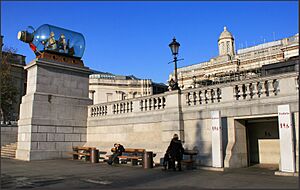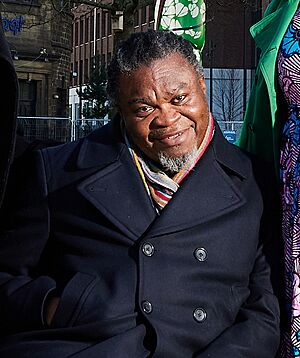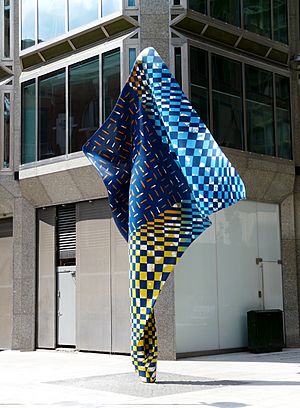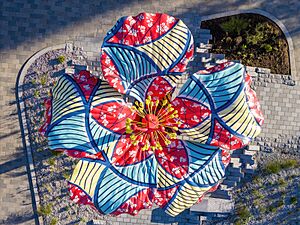Yinka Shonibare facts for kids
Yinka Shonibare (born August 9, 1962) is a famous British artist. He lives and works in the United Kingdom. His art often explores big ideas like cultural identity, how countries have been affected by colonialism (when one country takes control of another), and how different cultures mix in today's global world. A special part of his art is the bright, colourful Ankara fabric he uses. Because Shonibare has a physical disability that affects one side of his body, he works with assistants who help him create his amazing pieces.
Contents
Early Life and Education
Yinka Shonibare was born in London, England, on August 9, 1962. His parents were Olatunji and Laide Shonibare. When he was three years old, his family moved to Lagos, Nigeria, where his father worked as a lawyer.
At age 17, Shonibare returned to the UK for his high school studies. When he was 18, he got a condition called transverse myelitis. This caused inflammation in his spinal cord, leading to a long-term physical disability where one side of his body became paralysed.
Shonibare studied Fine Art at two well-known schools: first at Byam Shaw School of Art and then at Goldsmiths, University of London. He earned his master's degree from Goldsmiths and became part of the group known as the Young British Artists. After finishing his studies, Shonibare worked for an organisation called Shape Arts. This group helps make art available to people with disabilities.
Amazing Artworks and Career
In 1999, Shonibare created four unique sculptures called Dysfunctional Family. These pieces showed a mother and daughter in white and blue, and a father and son in red and yellow.
His art has been shown at major art events like the Venice Biennial and in top museums around the world. In 2002, he was asked to create a special work for an exhibition called documenta XI. This piece, Gallantry and Criminal Conversation, helped him become known internationally.
In 2004, Shonibare was nominated for the Turner Prize, a very important art award. This was for his exhibition Double Dutch and a solo show in London. Many people liked his work that year. A BBC poll showed that 64% of voters chose his art as their favourite.
Shonibare has received many honours for his contributions to art. He became an Honorary Fellow of Goldsmiths' College in 2003. He was also awarded an MBE in 2004 and a CBE in 2019. In 2013, he was elected a Royal Academician by the Royal Academy of Arts.
His major art shows have travelled to many places. In 2008, a big exhibition of his work started in Sydney, Australia. It then moved to the Brooklyn Museum in New York in 2009 and the National Museum of African Art in Washington DC.
In 2010, Shonibare created Nelson's Ship in a Bottle. This was his first public art project for the Fourth Plinth in Trafalgar Square, London. It was a very popular artwork.
On December 3, 2016, one of his Wind Sculpture pieces was placed permanently outside the Smithsonian's National Museum of African Art in Washington, DC. This colourful sculpture, Wind Sculpture VII, was the first to be installed there.
Shonibare also runs Guest Projects, a special space in London for new artists. He is planning to open similar spaces in Lagos, Nigeria.
In 2023, his first public artwork in Leeds was revealed. It is called Hibiscus Rising. This sculpture remembers David Oluwale, a Nigerian homeless man who faced unfair treatment in Leeds.
What His Art Explores

Shonibare's art looks at important topics like colonialism, race, and social class. He uses many different art forms, including painting, sculpture, photography, and film. He especially explores how identity is formed and the complex connections between Africa and Europe, including their economic and political pasts. He often uses ideas from Western art history and literature.
Shonibare describes himself as a "post-colonial" artist, meaning his work questions what cultural and national identities truly mean. While he gets ideas from his own life, he also finds inspiration from all over the world. He once said, "I'm a citizen of the world, I watch television so I make work about these things."
A key material in Shonibare's art since 1994 is the bright "African" fabric. He buys this fabric from Brixton market in London. He explains that these fabrics are not truly "African" in origin as many people think. They actually have a mixed cultural background. He likes this idea because it shows how culture is often "an artificial construct" or something that is made up. These fabrics were first made in Europe to be sold in Asian markets. When they weren't popular there, they were sold in Africa. Today, major producers of this "African" fabric are in Manchester, UK, and the Netherlands. Even though it's a European invention, many Africans in England, like Shonibare, use this Dutch wax fabric. He often uses these fabrics to create European 18th-century style dresses for his sculptures.
Shonibare is famous for creating life-size sculptures of people without heads. These figures are carefully placed and dressed in his vibrant wax cloth patterns. This makes you think about history and racial identity in new ways. For example, in his 2003 artwork Scramble for Africa, Shonibare shows the Berlin Conference of 1884–1885. During this meeting, European leaders divided up Africa among themselves. The headless figures in this piece suggest a loss of humanity. Shonibare explained that he wanted to show these European leaders as "mindless in their hunger" for African resources. This artwork also makes us think about how history can repeat itself.
Shonibare's Trumpet Boy is a permanent artwork at The Foundling Museum. This sculpture also uses his colourful fabric. It was made to fit the museum's theme of "found" objects, connecting to its history.
He also recreates famous paintings by other artists. He uses headless figures dressed in Batik or Ankara textiles instead of traditional European fabrics. This creates a "culture clash" and explores how cultures interact after colonialism. Examples include Gainsborough's Mr and Mrs Andrews Without Their Heads (1998) and Reverend on Ice (2005), which is based on a painting by Henry Raeburn.
One artist Shonibare often refers to is Jean-Honoré Fragonard. He recreated Fragonard's series The Progress of Love. In his version of The Swing (After Fragonard) (2001), the woman on the swing wears a fake Chanel patterned fabric. Using this fabric helps him explore ideas of post-colonialism, globalism, and how cultures mix. It also comments on how much we buy and consume in the modern world.
Shonibare also takes carefully posed photographs and videos. In these, he recreates famous British paintings or stories from books. He often plays the main character himself, appearing as a stylish black British "dandy." Examples include Diary of A Victorian Dandy (1998), based on A Rake's Progress by William Hogarth, and Dorian Gray (2001), named after Oscar Wilde's novel The Picture of Dorian Gray.
His artwork Nelson's Ship in a Bottle was much larger than a typical ship in a bottle, but still a 1:30 scale model of the real HMS Victory. This artwork was the first on the Fourth Plinth to specifically connect to the history of Trafalgar Square, which celebrates the Battle of Trafalgar. It was displayed from May 24, 2010, to January 30, 2012, and was very popular. In 2011, money was raised to buy the sculpture, and it now has a permanent home at the National Maritime Museum in Greenwich.
Other works by Shonibare include printed ceramics, and items like shoes, furniture, walls, and bowls covered in his signature fabric.
In October 2013, Shonibare took part in Art Wars at the Saatchi Gallery. For this, artists were given a stormtrooper helmet to turn into a work of art. The money raised went to a fund to find a missing person.
In 2018, a new art museum in South Africa, the Norval Foundation, bought Shonibare's Wind Sculpture (SG) III. This was the first of his Wind Sculpture pieces to be permanently displayed on the African continent.
Shonibare has also worked with Bellerby & Co, Globemakers, who make globes.
Awards and Recognition
In 2004, Shonibare was given the title Member of the Order of the British Empire (MBE). He humorously includes this title in his artistic name. He believes it's "better to make an impact from within rather than from without." He sees it like a "Trojan horse," where you go in quietly and then make a big change.
In 2019, Yinka Shonibare received an even higher honour, the Commander of the Order of the British Empire (CBE).
In March 2021, Shonibare received the Whitechapel Gallery Art Icon Award. This award celebrates artists who have made very important contributions to a specific art form. He was the eighth artist to receive this honour.
Disability and Art
Yinka Shonibare's disability has increased as he has gotten older. He now uses an electric wheelchair. Because of his physical limitations, he cannot make all his artworks by himself. He works as a conceptual artist, meaning he comes up with the ideas and directs a team of assistants to create the physical pieces.
Shonibare has openly talked about his disability and how it plays a role in his creative work. In 2013, he became a patron for the annual "Open" exhibition by Shape Arts. This exhibition invites both disabled and non-disabled artists to submit their work based on a chosen theme.





